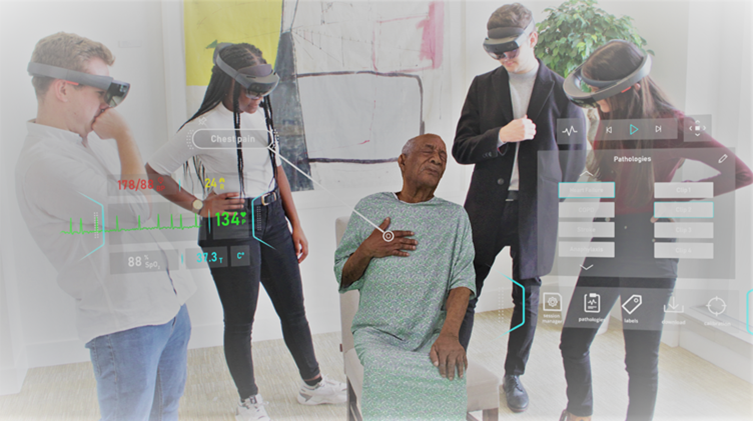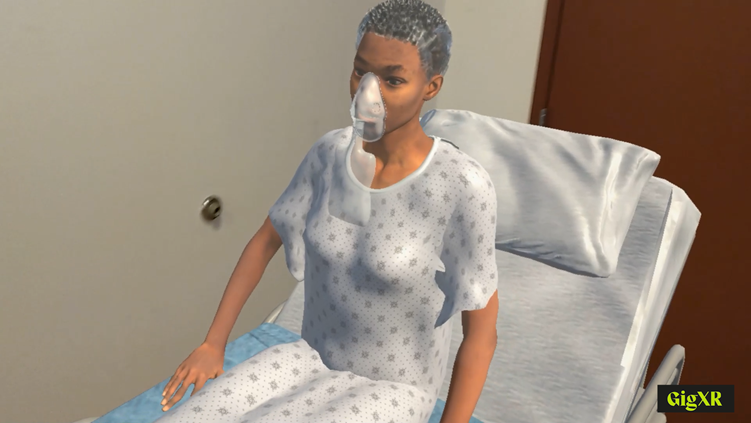The technology enables world-class teaching and learning through life-like holographic patient scenarios, accessible from anywhere in the world.
The new mixed-reality training application is called HoloScenarios and is being developed by Cambridge University Hospitals NHS Foundation Trust (CUH), in partnership with the University of Cambridge and Los Angeles based tech company GigXR.
The first module focuses on common respiratory conditions and emergencies. Learners in the same room, wearing Microsoft HoloLens mixed reality headsets, are able to see each other in real life, while also interacting with a multi-layered, medically accurate holographic patient. This creates a unique environment to learn and practice vital, real-time decision making and treatment choices.
Through the same type of headset, medical instructors are able to change patient responses, introduce complications and record observations and discussions, whether in person in a teaching group or remotely to multiple locations worldwide, via the internet.
Learners can also watch, contribute to and assess the holographic patient scenarios from Android, iOS smartphone or tablet. This means true-to-life, safe-to-fail immersive learning can be accessed, delivered and shared across the world, with the technology now available for license to learning institutions everywhere.
The first module features a hologram patient with asthma, followed by anaphylaxis, pulmonary embolism and pneumonia. Further modules in cardiology and neurology are in development.

Leading the project in Cambridge is Dr Arun Gupta, consultant anaesthetist at CUH and director of postgraduate education at Cambridge University Health Partnership. He said: “Mixed reality is increasingly recognised as a useful method of simulator training. As institutions scale procurement, the demand for platforms that offer utility and ease of mixed reality learning management is rapidly expanding
“GigXR has already enabled instructors to better prepare learners with medically accurate simulation for observation and assessment. With HoloScenarios, we’re helping to evolve education from a mentorship-based model to one where students around the world can have equal access to top-flight expertise for mastering invention-based clinical skills.”
Delivered by the Gig Immersive Learning Platform, HoloScenarios aims to centralise and streamline access and management of mixed reality learning, and encapsulate the medical experience of world-leading doctors at CUH and across the University of Cambridge.
The new technology could also provide more flexible, cost-effective training without heavy resource demands of traditional simulation, which can make immersive training financially prohibitive. This includes costs for maintaining simulation centres, their equipment and the faculty and staff hours to operate the labs and hire and train patient actors.
David King Lassman, founder of GigXR, said: “Empowering instructors with 360-degree preparation for clinical practice represents a milestone for GigXR that allows us to provide our customers with a library of applications that offers solutions for students from their first courses to continuing education.”
“Our first HoloScenarios module represents a new and incredibly powerful way to use mixed reality for healthcare training, to be followed up by many more modules and new applications delivered soon.”
Alongside the development and release of HoloScenarios, the University of Cambridge is carrying out research to evaluate learner and patient outcomes using mixed reality, as well as evaluating the products and resulting efficiencies for institutions.
Riikka Hofmann, professor in the Faculty of Education, University of Cambridge, is leading an analysis of the new HoloScenarios technology as a teaching and learning resource. She said:
“Our research is aimed at uncovering how such simulations can best support learning and accelerate the adoption of effective mixed reality training while informing ongoing development.”
“We hope that it will help guide institutions in implementing mixed reality into their curricula, in the same way institutions evaluate conventional resources, such as textbooks, manikins, models or computer software, and, ultimately, improve patient outcomes.”
Professor Sir Stephen Powis, NHS national medical director said: “The NHS has always been at the forefront of medical innovation, and this unique development by teams in Cambridge – to use life-like holographic patients in medical training – could enhance the learning experience of our next generation of doctors, nurses and healthcare workers, by creating new environments to practice medicine in real time, while improving access to training worldwide.”
For more information on the Gig Immersive Learning Platform, visit www.gigxr.com.
Image credit: GigXR



